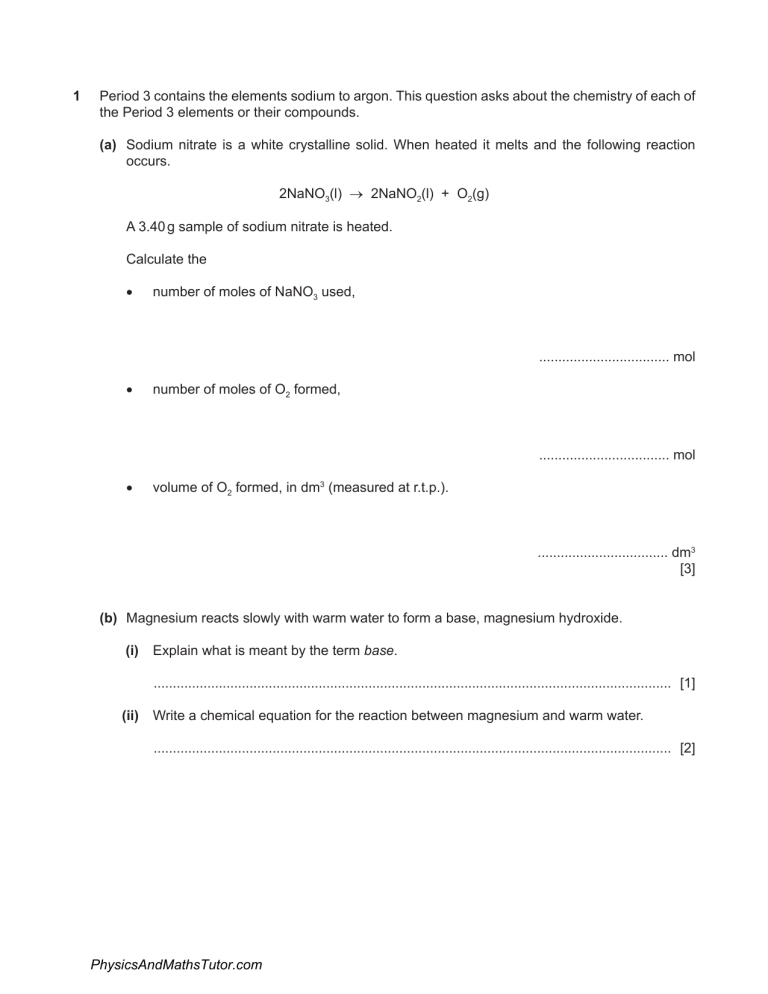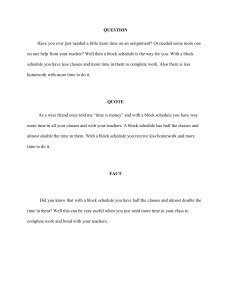
1 Period 3 contains the elements sodium to argon. This question asks about the chemistry of each of the Period 3 elements or their compounds. (a) Sodium nitrate is a white crystalline solid. When heated it melts and the following reaction occurs. 2NaNO3(l) → 2NaNO2(l) + O2(g) A 3.40 g sample of sodium nitrate is heated. Calculate the • number of moles of NaNO3 used, .................................. mol • number of moles of O2 formed, .................................. mol • volume of O2 formed, in dm3 (measured at r.t.p.). .................................. dm3 [3] (b) Magnesium reacts slowly with warm water to form a base, magnesium hydroxide. (i) Explain what is meant by the term base. ....................................................................................................................................... [1] (ii) Write a chemical equation for the reaction between magnesium and warm water. ....................................................................................................................................... [2] PhysicsAndMathsTutor.com (c) Aluminium oxide is amphoteric. It is insoluble in water. Describe experiments to show that aluminium oxide is amphoteric. .................................................................................................................................................... .................................................................................................................................................... .................................................................................................................................................... .............................................................................................................................................. [3] (d) Silicon(IV) oxide has a giant structure. (i) Name the type of bonding in silicon(IV) oxide. ....................................................................................................................................... [1] (ii) Give two physical properties of silicon(IV) oxide. ............................................................................................................................................. ....................................................................................................................................... [2] (e) Calcium phosphate is used in fertilisers. The bonding in calcium phosphate is ionic. Calcium phosphate contains the phosphate ion, PO43–. (i) What is ionic bonding? ............................................................................................................................................. ....................................................................................................................................... [2] (ii) Deduce the formula of calcium phosphate. ....................................................................................................................................... [1] PhysicsAndMathsTutor.com (f) 4 S(g) + 2F2(g) → SF4(g) The reaction is exothermic. (i) Complete the energy level diagram for this reaction. Include an arrow which clearly shows the energy change during the reaction. S(g) + 2F2(g) energy [3] (ii) During the reaction the amount of energy given out is 780 kJ / mol. The F–F bond energy is 160 kJ / mol. Use this information to determine the bond energy, in kJ / mol, of one S–F bond in SF4. F S + F F F → F F S F F .................................. kJ / mol [3] PhysicsAndMathsTutor.com (g) Chlorine and compounds of chlorine are important in water treatment and in laboratory testing for water. (i) Chlorine is added to water to make the water safe to drink. Explain why adding chlorine makes water safe to drink. ....................................................................................................................................... [1] (ii) A compound of chlorine is used in the laboratory to test for the presence of water. Name the compound of chlorine used in this test and describe the colour change seen in a positive result of this test. name of compound ............................................................................................................. colour change from ................................................... to ................................................... [3] (h) Argon is an unreactive noble gas. (i) Explain why argon is unreactive. ....................................................................................................................................... [1] (ii) Give one use of argon. ....................................................................................................................................... [1] [Total: 27] PhysicsAndMathsTutor.com 2 (a) Propane reacts with chlorine to form a mixture of chloropropanes. This is a photochemical reaction. (i) What is meant by the phrase photochemical reaction? ...................................................................................................................................... ...................................................................................................................................... . [1] (ii) The products of this reaction include two isomers, one of which has the following structural formula. H H H H C C C H H H Cl Draw the structural formula of the other isomer. [1] (iii) Explain why these two different compounds are isomers. ...................................................................................................................................... ....... ............................................................................................................................ [2] PhysicsAndMathsTutor.com (b) Bond breaking is an endothermic change and bond forming is an exothermic change. Bond energy is the amount of energy in kJ / mol needed to break one mole of the specified bond. H H H H C C C H H H H + C l Cl → H H H H C C C H H Cl + H H Use the following bond energies to determine whether this reaction is exothermic or endothermic. You must show your reasoning. bond bond energies in kJ / mol C–Cl 338 C–H 412 Cl –Cl 242 H–Cl 431 C–C 348 .................................................................................................................................................... .................................................................................................................................................... .................................................................................................................................................... .............................................................................................................................................. [3] PhysicsAndMathsTutor.com Cl (c) (i) Chloropropane can be hydrolysed to propanol, CH3CH2CH2OH, by sodium hydroxide. Write the equation for this reaction. .................................................................................................................................[2].. (ii) Propanol can be dehydrated. It loses a water molecule to form a hydrocarbon. Give the name and structural formula of this hydrocarbon. name ................................................. structural formula [2] (iii) Propanol is oxidised to a carboxylic acid by acidifiedpotassiummanganate( VII). Deduce the name of this acid. ....................................................................................................................................... [1] PhysicsAndMathsTutor.com (d) Propanol reacts with methanoic acid to form the ester propyl methanoate. CH3CH2CH2OH + HCOOH → HCOOCH2CH2CH3 + H2O 4.0 g of methanoic acid was reacted with 6.0 g of propanol. [1] (i) Calculate the Mr of methanoic acid = ........................................ (ii) Calculate the Mr of propanol = ........................................ (iii) [1] Determine which one is the limiting reagent. Show your reasoning. ............................................................................................................................................. ............................................................................................................................................. [2] ....................................................................................................................................... (iv) Calculate the maximum yield in grams of propyl methanoate, Mr = 88. ....................................................................................................................................... [1] [Total: 17] PhysicsAndMathsTutor.com 3 Ammonia is made by the Haber process. N2(g) + 3H2(g) 2NH3(g) The forward reaction is exothermic. The conditions in the reaction chamber are: ● ● ● a pressure of 200 atmospheres, a catalyst of finely divided iron, a temperature of 400 to 450 °C. (a) What are the two advantages of using a high pressure? Give a reason for both. advantage 1 ............................................................................................................................... reason ........................................................................................................................................ .................................................................................................................................................... advantage 2 ............................................................................................................................... reason ........................................................................................................................................ .................................................................................................................................................... [4] (b) A higher temperature would give a faster reaction rate. Why is a higher temperature not used? .................................................................................................................................................... .................................................................................................................................................... .............................................................................................................................................. [3] Why is the iron catalyst used as a fine powder? (c) c) ............................................................................................................................................. ....................................................................................................................................... [1] (ii) Give two reasons why a catalyst is used. ............................................................................................................................................. ............................................................................................................................................. ............................................................................................................................................. ....................................................................................................................................... [2] PhysicsAndMathsTutor.com (d) The equilibrium mixture leaving the reaction chamber contains 15% ammonia. Suggest how the ammonia could be separated from the mixture. boiling point / °C hydrogen –253 nitrogen –196 ammonia –33 .................................................................................................................................................... .............................................................................................................................................. [2] (e) Ammonia is used to make nitrogen trifluoride, NF3. Nitrogen trifluoride is essential to the electronics industry. It is made by the following reaction. H N H H + F F F F F F → F N F F + H H H F F F Determine if the above reaction is exothermic or endothermic using the following bond energies and by completing the following table. The first line has been done as an example. Bond energy is the amount of energy, in kJ / mole, needed to break or make one mole of the bond. bond bond energy in kJ / mole N–H 390 F–F 155 N–F 280 H–F 565 bond energy change / kJ N–H (3 × 390) = 1170 F–F N–F H–F .................................................................................................................................................... .............................................................................................................................................. [4] [Total: 16] PhysicsAndMathsTutor.com 4 All metal nitrates decompose when heated. A few form a nitrite and oxygen. Most form the metal oxide, oxygen and a brown gas called nitrogen dioxide. (a) (i) Name a metal whose nitrate decomposes to form the metal nitrite and oxygen. .............................................................................................................................. [1] (ii) Complete the equation for the action of heat on lead(II) nitrate. ......Pb(NO3)2 → ......... + ......NO2 + O2 [2] (iii) Suggest why the nitrate of the metal, named in (a)(i), decomposes less readily than lead(II) nitrate. .................................................................................................................................... .............................................................................................................................. [2] PhysicsAndMathsTutor.com (b) Almost all samples of nitrogen dioxide are an equilibrium mixture of nitrogen dioxide, NO2, and dinitrogen tetroxide, N2O4. forward reaction 2NO2(g) dark brown reverse reaction N2O4(g) colourless In the forward reaction, a bond forms between the two nitrogen dioxide molecules. NO2 + NO2 → O2N – NO2 (i) Explain the term equilibrium mixture. .................................................................................................................................... .............................................................................................................................. [1] (ii) The syringe contains a sample of the equilibrium mixture. The plunger was pulled back reducing the pressure. How would the colour of the gas inside the syringe change? Give an explanation for your answer. equilibrium mixture sealed end gas syringe .................................................................................................................................... .................................................................................................................................... .............................................................................................................................. [3] (iii) A sealed tube containing an equilibrium mixture of nitrogen dioxide and dinitrogen tetroxide was placed in a beaker of ice cold water. The colour of the mixture changed from brown to pale yellow. Is the forward reaction exothermic or endothermic? Give an explanation for your choice. .................................................................................................................................... .............................................................................................................................. [2] (iv) What other piece of information given in the equation supports your answer to (iii)? NO2 + NO2 → O2N–NO2 .............................................................................................................................. [1] [Total: 12] PhysicsAndMathsTutor.com



